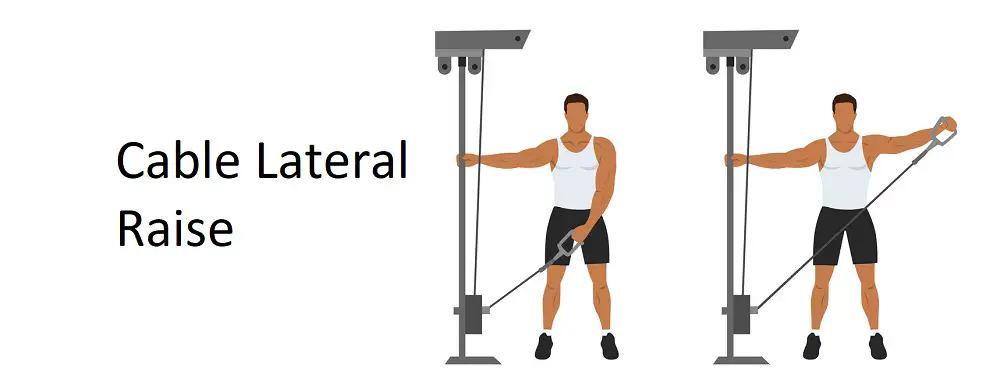The Cable Lateral Raise is a shoulder isolation exercise that targets the lateral deltoids, helping to build strength and definition in the side of the shoulders. In this comprehensive guide, we’ll delve into the correct technique, benefits, alternatives, and other essential details associated with the Cable Lateral Raise.
Instructions
Setup:
- Cable Machine Setup: Adjust the pulley of the cable machine to the lowest position and attach a single-handle or D-handle to the cable.
- Positioning: Stand sideways to the cable machine with your feet shoulder-width apart and knees slightly bent. Grasp the handle with your hand closest to the machine, palm facing your body.
Execution:
- Lifting Motion: Keeping your arm straight and maintaining a slight bend in your elbow, exhale as you lift the handle out to the side until your arm is parallel to the ground. Keep your wrist in a neutral position throughout the movement.
- Controlled Lowering: Inhale as you lower the handle back down to the starting position in a slow and controlled manner, resisting the weight of the cable.
- Repeat: Perform the desired number of repetitions on one side before switching to the other side.
Tips:
- Keep your shoulders down and away from your ears throughout the exercise to avoid shrugging.
- Focus on using the lateral deltoid to lift the weight, rather than momentum or swinging.
- Control the movement throughout the entire range of motion to maximize effectiveness.
Benefits
- Lateral Deltoid Development: The Cable Lateral Raise primarily targets the lateral deltoids, helping to build strength and size in the side of the shoulders, contributing to a balanced and well-rounded shoulder appearance.
- Shoulder Stability: Performing the exercise with cables provides constant tension throughout the movement, helping to improve shoulder stability and control.
- Muscle Isolation: The Cable Lateral Raise isolates the lateral deltoids, minimizing involvement from other muscle groups and allowing for targeted development of the shoulders.
- Range of Motion: Using cables allows for a smooth and controlled range of motion, reducing the risk of joint strain and injury.
Muscles Worked in Cable Lateral Raise
The Cable Lateral Raise primarily targets the lateral deltoid muscles, which are located on the side of the shoulders. Additionally, the exercise engages the following muscles to a lesser extent:
- Anterior Deltoid: The front portion of the deltoid muscles also assists in lifting the arm during the Cable Lateral Raise.
- Trapezius: The trapezius muscles, particularly the middle fibers, help stabilize the shoulder blades and support the movement of the arms away from the body.
- Supraspinatus: This small muscle located above the shoulder blade assists in the initial phase of lifting the arm laterally.
- Serratus Anterior: The serratus anterior muscles, located on the sides of the rib cage, assist in stabilizing the shoulder blades and supporting arm movement.
Overall, the Cable Lateral Raise primarily targets the lateral deltoids, but it also engages several other muscles of the shoulder complex to provide stability and support during the exercise.
Alternate names for Cable Lateral Raise:
- Cable Side Raise
- Cable Lateral Fly
- Cable Side Delt Raise
- Cable Lateral Shoulder Raise
Alternatives
- Dumbbell Lateral Raise: Similar to the cable variation, but performed with dumbbells instead of cables, allowing for greater freedom of movement and unilateral training.
- Machine Lateral Raise: Utilize a lateral raise machine, which provides stability and support while targeting the lateral deltoids.
- Resistance Band Lateral Raise: Perform the exercise with resistance bands anchored at floor level or attached to a high anchor point, providing variable resistance throughout the movement.
- Plate Lateral Raise: Hold weight plates in each hand and lift them laterally to shoulder height, targeting the lateral deltoids with added resistance.
Conclusion
Incorporating the Cable Lateral Raise into your shoulder workout routine can help strengthen and define the lateral deltoids, contributing to a balanced and aesthetic physique. Focus on proper form, control the movement, and consider incorporating alternative exercises to keep your workouts varied and challenging.
Also, check the Barbell Rear Delt Row








